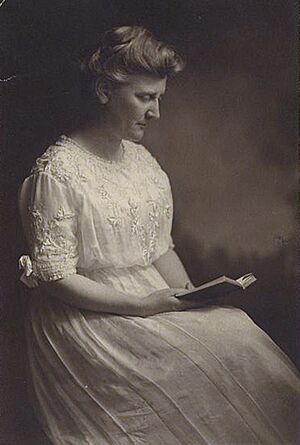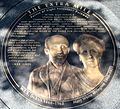Mary White Ovington facts for kids
Mary White Ovington (born April 11, 1865 – died July 15, 1951) was an American journalist and a strong supporter of women's rights. She is best known as a co-founder of the National Association for the Advancement of Colored People (NAACP), a very important group that fought for equal rights for African Americans.
Contents
Early Life and Inspiration
Mary White Ovington was born in Brooklyn, New York, on April 11, 1865. Her parents were members of the Unitarian Church and believed strongly in women's rights. They had also been involved in the movement to end slavery, called anti-slavery.
Mary went to school at the Packer Collegiate Institute and Radcliffe College. She became interested in civil rights in the 1890s. She was inspired after hearing famous speakers like Frederick Douglass and Booker T. Washington.
Fighting for Better Lives
In 1894, Mary met Ida B. Wells, another important civil rights leader. Mary was shocked by the poor living conditions she saw in some parts of the city. She began working with Ida to make the city improve these areas. In 1895, Mary helped start the Greenpoint Settlement in Brooklyn, which was a community center to help people.
From 1896 to 1904, Mary led this project. Later, she studied problems with jobs and housing for black people in Manhattan. During her research, she met W. E. B. Du Bois, who was also a key figure in the fight for civil rights. She also learned about the Niagara Movement, which was a group working for racial equality.
Joining the Fight for Equality
In 1905, Mary Ovington joined the Socialist Party of America. She believed that problems related to race were also connected to how society was divided by wealth and class. She wrote articles for newspapers and magazines like The Masses and the New York Evening Post. She also worked with writer Ray Stannard Baker, influencing his book about racial issues.
Founding the NAACP
A major event that led to the creation of the NAACP happened in 1908. Mary read an article about a terrible race riot in Springfield, Illinois, where several African Americans were killed and homes were destroyed. The article called for strong citizens to help black people.
Mary Ovington responded to this call. She met with the article's author, William English Walling, and social worker Dr. Henry Moskowitz. They decided to organize a national meeting to discuss the civil and political rights of African Americans. This meeting was planned for February 12, 1909, which was the 100th birthday of Abraham Lincoln.
The Birth of a Movement
The first meeting of what would become the National Negro Committee took place in New York in May 1909. By May 1910, this group officially formed the National Association for the Advancement of Colored People (NAACP). Mary Ovington was chosen as its executive secretary. Many important people joined, including Josephine St. Pierre Ruffin, Mary Church Terrell, Jane Addams, and W. E. B. Du Bois.
Mary Ovington also continued to support women's suffrage, which was the right for women to vote. She was also a pacifist, meaning she was against war, and she opposed the United States joining World War I.
NAACP's Work and Achievements
After World War I, Mary Ovington continued to serve the NAACP as a board member and even as chairman. She encouraged many women to join the organization, making it a diverse group.
The NAACP fought a long legal battle against racial segregation (keeping people of different races separate) and racial discrimination (treating people unfairly because of their race). They worked to end discrimination in housing, education, jobs, voting, and transportation. The NAACP took cases to the Supreme Court, winning important decisions that helped protect voting rights and housing for African Americans.
Inspiring the Youth
In 1934, Mary White Ovington traveled to many colleges to give speeches. She wanted to show young people that the NAACP was a group where black and white people worked together. She especially wanted black youth to know that there were white people who also hated racial unfairness. She would show how many NAACP branches existed, proving how much progress the association had made.
Mary Ovington also wrote several books and articles. These included studies about black communities, books for children, and biographies of important African Americans. She also wrote a history of the NAACP.
Later Years and Legacy
Mary White Ovington retired from the NAACP board in 1947, after 38 years of dedicated service. She passed away on July 15, 1951, at the age of 86.
Mary White Ovington's legacy lives on. A middle school in Brooklyn is named in her honor. She is also recognized on The Extra Mile, a national memorial in Washington, D.C., that honors volunteers. In 2009, she was featured on a United States postage stamp alongside Mary Church Terrell, another civil rights pioneer.
Images for kids
See also
 In Spanish: Mary White Ovington para niños
In Spanish: Mary White Ovington para niños



